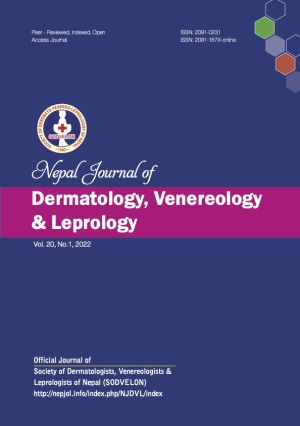Leprosy Care in the Era of COVID - 19
DOI:
https://doi.org/10.3126/njdvl.v20i1.43034Keywords:
COVID-19, Leprosy, Pandemic, World Health OrganizationAbstract
Leprosy care services are facing several challenges with the advent of the global COVID 19 pandemic.
The impact on case detection has been felt globally with the annual new cases declining by 37.1% from 2019 to 2020. This trend reflects the disruption in routine health care services and active case finding activities than a true drop in the incidence of leprosy. There are marked differences in the major determinants of the leprosy burden even within countries of south Asia. Disease modelling has indicated that well over 100% of new cases of leprosy have gone unreported during the pandemic.
Even though availability of MDT has not suffered significantly, other services like active case finding, post exposure prophylaxis and reconstructive surgery have been curtailed to a great extent. The use of new technology and social media to reach patients and deliver care have been encouraged.
Co infection has not shown any significant effect on either leprosy or COVID 19. Even patients who are on immunosuppressants for lepra reactions have not been shown to have a bad outcome in the face of coinfection. Continuation of MDT during active infection with COVID 19 has been recommended as both dapsone and clofazimine have shown anti-coronaviral activity.
Stigma and social discrimination have not been studied in detail. It is postulated that patients affected by leprosy may suffer more social discrimination as both leprosy and COIVD 19 have been associated with stigma.
Urgent action is needed to improve case detection in leprosy on a global scale as delay in diagnosis and treatment may lead to further nerve damage and disability.
Key Words: COVID-19; leprosy; Pandemic; World Health OrganizationDownloads
Downloads
Published
How to Cite
Issue
Section
License
Copyright (c) 2022 Society of Dermatologists, Venereologists and Leprologists of Nepal

This work is licensed under a Creative Commons Attribution 4.0 International License.
Copyright on any research article is transferred in full to Nepal Journal of Dermatology, Venereology & Leprology upon publication. The copyright transfer includes the right to reproduce and distribute the article in any form of reproduction (printing, electronic media or any other form).




